新小升初英语基础语法复习辅导教材
- 格式:doc
- 大小:673.75 KB
- 文档页数:83

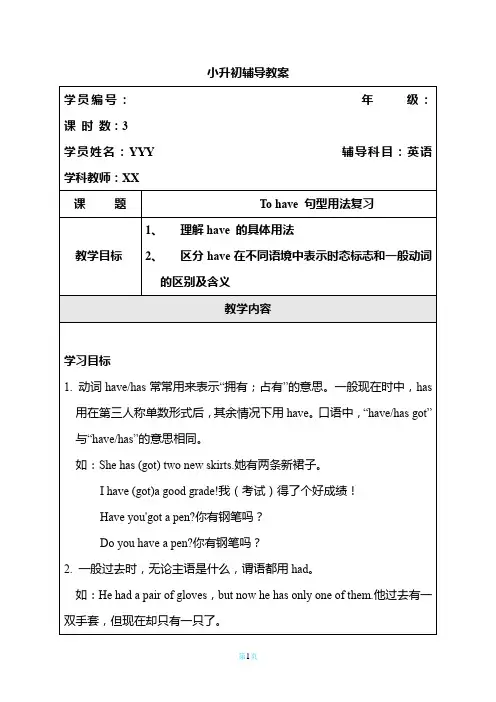
小升初辅导教案听力训练1. 根据听到的单词或短语,判断应该用have还是has作谓语动词,写在下面横线上(1) ______ (2) _____ (3) _____ (4) ____(5) ______ (6) _____ (7) _____ (8) ____2. 根据听到的问题为下列回答编号( ) Next Tuesday, maybe.() I've got a cat.() ¥20, in all.() She has got a skirt.() No, she hasn't.() Yes, I have.趣味阅读读一读下面的短文,选择最佳答案回答问题A champion athlete in bed with a cold was told that he had a temperature. "How high is it, doctor?" he asked. "A hundred and four." "What is the world's record?"() 1. Why was the athlete in bed? Because he.A. liked to see the doctorB.wanted to make a new world's recordC.caught a cold( ) 2. "A hundred and four, "means_ .A.a hundred and four years oldB.a hundred and four degrees centigradeC.a hundred and four degrees Fahrenheit() 3. The word "record" in "the world's record" means.A. 唱片B. 记录C. 录音Part 2I.Fill in the blanks with "am, is, are, have, has". (用am, is, are, have, has 填空)1.Mr. James_____ a happy family.2.The boys in blue_____ g ot a football.3.Here _______ some bread. There_____ s ome noodles.4.Who _______ got a skateboard? Ben.5.My teachers ______ got many books.6.Can I______ some water?7.What______ his aunt got?8.He______ some sand in his hand.9.How much _____ the grapes? Twenty yuan.10.I _______ a boy. I______ a football.11. _______ their friend got any pears?12.What shape______ the biscuit?Keys: 1. has 2. have 3. is, are 4. has 5. have 6. have7. has 8. has 9. are 10. am, have 11. Has 12. isⅡ.Fill in the blanks.1.Eddie _______ (not have) his lunch at 11:35 every day.2.Listen I The girls _____ (sing) in the music room.3.Her uncle ______ (have) a nice bag.4.Her teacher_____ (have) a pink dress last year.5.Are you writing? No, I___ (be not).6. _______ (have) the girl got any dolls? No, she(have not).7.Eddie ______ (have) his breakfast at school.8.Look, that boy in black ___ (have) a Gameboy. He ___ (play) it now.9.Let's_______ (have) dinner now.10.What_____ _(have) you got? An umbrella.Ⅲ. Choose the best answer.( ) 1. How much are these __ toys?A. big redB. red bigC. black new ( ) 2. Is this bear yours? Yes, _ mine.A. there'sB. they'reC. it's( ) 3. They _____ four lessons in the morning.A. are havingB. hasC. have( ) 4. Have they got ___ milk? Yes, they've got ____ in the bottle.A. any .. . someB. any . . . anyC. some .. . any () 5. Mrs. Li ______ some flour. The flour___ in her bag.A. have ... isB. has ... areC. has ... is () 6. Can I_______ cakes? OK. Here you are.A. have someB. have anyC. eat any() 7. Let's ______ our class now.A. havingB. hasC. have( ) 8. George likes to play football. But he any footballs.A. hasn'tB. is havingC. haven't() 9. Mr. Hu ______ got any sheep on his farm.A. haveB. hasC. hasn't() 10. I can ______ lunch at 11:00 and my sister can__ lunch at 11:30.A. have . . . hasB. has . . . haveC. have . . . haveKeys: 1. A 2. C 3. C 4. A 5. C 6. A 7. C 8. A 9. C 10. C10. She has a big ball in her hands. (对划线部分提问)V.Read and match.() 1.What have you got?A: A football.() 2.How many sweets has he got?B: Thank you.() 3.Have they got any drinks?C: No, she has a toy rabbit. () 4.Have some hot dogs, please.D: Alice.() 5.Has Alice got a doll?E: Yes.() 6.Who has got any toy rabbits?F: Twelve.。
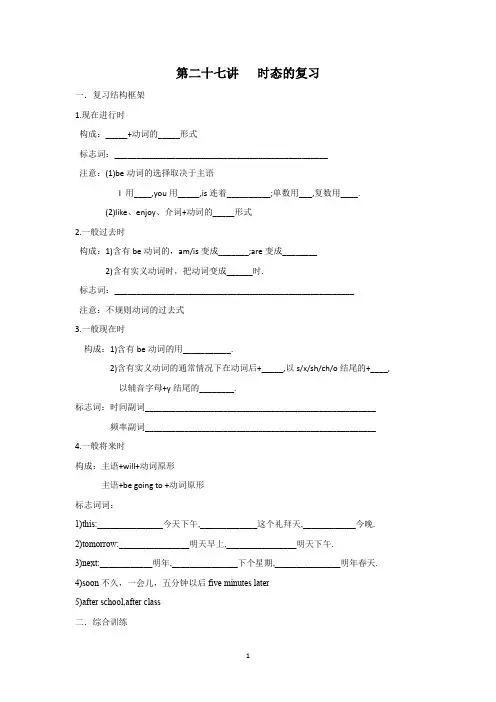
第二十七讲时态的复习一.复习结构框架1.现在进行时构成:_____+动词的_____形式标志词:_________________________________________________注意:(1)be动词的选择取决于主语I 用____,you用_____,is连着__________;单数用___,复数用____.(2)like、enjoy、介词+动词的_____形式2.一般过去时构成:1)含有be动词的,am/is变成_______;are变成________2)含有实义动词时,把动词变成______时.标志词:_______________________________________________________注意:不规则动词的过去式3.一般现在时构成:1)含有be动词的用___________.2)含有实义动词的通常情况下在动词后+_____,以s/x/sh/ch/o结尾的+____,以辅音字母+y结尾的________.标志词:时间副词_____________________________________________________频率副词_____________________________________________________ 4.一般将来时构成:主语+will+动词原形主语+be going to +动词原形标志词词:1)this:_______________今天下午,_____________这个礼拜天,____________今晚.2)tomorrow:________________明天早上,________________明天下午.3)next:____________明年,_______________下个星期,_______________明年春天.4)soon不久,一会儿,五分钟以后five minutes later5)after school,after class二.综合训练(一)单项选择1.Listen!The boy___in his room.A.singB.is singingC.singsD.will sing2.Both Tom and Tony______swimming yesterday.A.goB.wentC.is goingD.will go3.---What’s your sister doing there? ---______.A.She read newspapersB.She reads newspaperC.She is reading newspapersD.She will read a newspaper4. ---What _____you do last week?---I did something bad at school.A.wereB.doC.doesD.did5. They are going to __________a film.A.seeingB.seeC.seesD.saw6.Is your brother ___a book or___TV?A.reading,lookingB.reading,watchingC.watching,lookingD.looking,watching7. My cousin often_______us stories at night.A.tellB.speakC.tellsD.talk8.---Where’s Tom?---He____his homework at home.A.doB.doesC.is doD.is doing9. ____he____his homework every evening?A.Does;doB.Do;doesC.Is;doingD.Does;does10. Do you enjoy______in the country?A.livingB.to liveC.livedD.live11. What _________Amy going to do next weekend?A.isB.areC.amD.does12. ---Where____you just now? ---I____at school.A.were;wereB.were;wasC.was;wereD.was;was13.Be quiet!My baby________.A.sleepingB.sleepC.is sleepingD.are sleeping14. His ruler____in his bag now.But he____it here an hour ago.A.is;putsB.was;putsC.is;putD.was;put15. Mary ____a good time in the park yesterday.A.hadB.haveC.hasD.will have16. He often_____to the movie,but he didn’t____yesterday.A.go;wentB.goes;goesC.goes;goD.go;go17. My eraser____on my desk ten minutes ago.But it______there now.A.is;wasn’tB.was;isn’tC.is;isn’tD.was;wasn’t18. We’re going to take a trip___________.A.tomorrowB.yesterdayC.todayD. last week19. Where ____your father from?A.areB.isC.doD.be20.He_______late for school in the afternoon.A.is oftenB.often comesC.often ises often (二)用所给单词正确形式填空1. Look!My classmates___________(run)on the playground.2. He________(fly)a kite last week.3. What about__________(go)fishing this afternoon?4.---What does he often do on Saturdays? ---He often______(stay)at home.5.She________(sing)every day.6.We_________(leave)Beijing tomorrow.7.They ______(be)in England five years ago.8.Look!The baby__________(eat)an apple.9.His parents ________(be)teachers.10.Mr.White__________(not have)supper at home every day.11.David_____________(play)football with his friends next week.12.My mother____________(not go)shopping yesterday evening.13.We both like____________(sit)on the grass.14.Jim____________(not work)here soon.15.Lily and Lucy_________(not speak)English at home.(三)句型转化1. He’s going to Shanghai at 2 o’clock.(划线部分提问)__________________________________________2.He does homework at night.(否定句)__________________________________________3. I go to school by bus.(划线部分提问)__________________________________________4.My father is a businessman.(否定句)___________________________________________5.She put a book in her bag just now.(一般疑问句+肯答)____________________________________________________________________6.They are having an English class now.(划线部分提问)____________________________________________7.I was at home yesterday.(一般疑问句+否答)____________________________________________________________________8.He had an egg for breakfast.(否定句)____________________________________________9.He will pass the exam.(否定句)____________________________________________10.He listens to music on Monday mornings.(划线部分提问)_____________________________________________(四)阅读理解Three men came to London for a holiday. They got to a very big hotel(旅馆) and took a room there. Their room was on the fortieth floor. In the evening the men came back very late.“I'm sorry, ”said the waiter(服务员) of the hotel, “but our lifts(电梯) are not working now. You can’t use them. If you don’t like to walk up to your room on the fortieth floor, we hope you stay here on the first floor. ”“No. ”said Tom, one of the three men, “we don’t like to stay here. We are going to walk upto the room. ”Then he said to the other two men, “It is hard to walk up to the fortieth floor. But we can make it easier. We will tell jokes(笑话) and sang songs when we are going up.So they started to walk up to their room. They were singing and telling jokes to each other on their way to the fortieth floor. When they got to the thirtieth floor, they found they left the key(钥匙) to their room on the first floor.1. The waiter of the hotel asked them because the lifts didn’t work.A. to sleep on the first floorB. to stay on the first floorC. to walk up to the room2. The men on the way to the room.A. told stories and sang songsB. read jokesC. make jokes on each other3. They remembered they left the key on the first floor when .A. they were on the 40th floorB. they were on the 20th floorC. they finished three quarters of the way(五)完型填空。
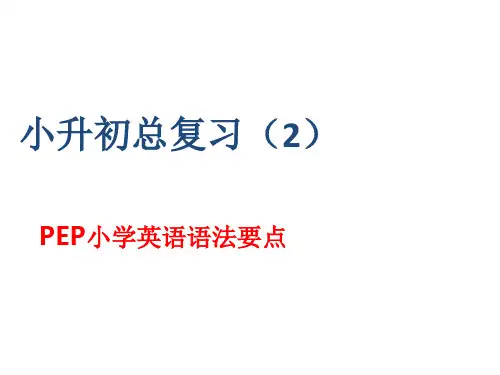
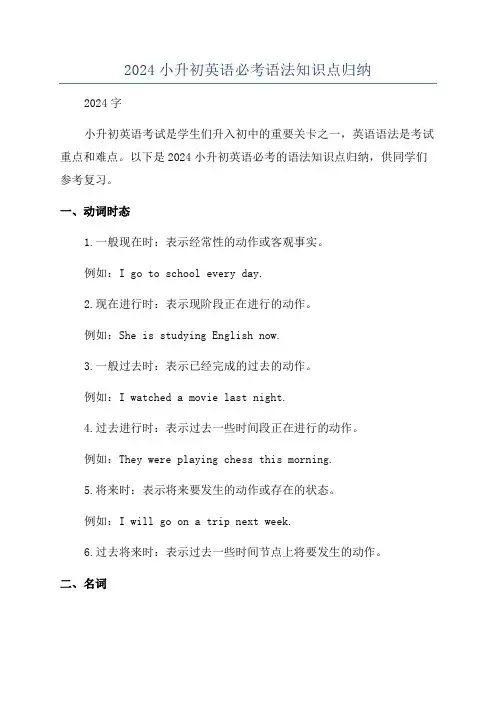
2024小升初英语必考语法知识点归纳2024字小升初英语考试是学生们升入初中的重要关卡之一,英语语法是考试重点和难点。
以下是2024小升初英语必考的语法知识点归纳,供同学们参考复习。
一、动词时态1.一般现在时:表示经常性的动作或客观事实。
例如:I go to school every day.2.现在进行时:表示现阶段正在进行的动作。
例如:She is studying English now.3.一般过去时:表示已经完成的过去的动作。
例如:I watched a movie last night.4.过去进行时:表示过去一些时间段正在进行的动作。
例如:They were playing chess this morning.5.将来时:表示将来要发生的动作或存在的状态。
例如:I will go on a trip next week.6.过去将来时:表示过去一些时间节点上将要发生的动作。
二、名词1.可数名词与不可数名词:可数名词有单数和复数之分,不可数名词只有单数形式。
例如:table(可数), water(不可数)2.名词所有格:表示所有关系时,在名词后加's。
例如:Tom's book(汤姆的书)3.复合名词:由两个或两个以上名词构成并有一定结构的名词。
例如:classroom, basketball三、形容词与副词1.形容词用来修饰名词,副词用来修饰动词、形容词或其他副词。
例如:She is a beautiful girl.(形容词修饰名词)He runs fast.(副词修饰动词)2. 形容词的比较级和最高级:一般在形容词后面加-er表示比较级,在形容词前面加the最高级。
例如:He is taller than me.(比较级)He is the tallest boy in our class.(最高级)四、代词1. 人称代词:主格形式有I, you, he, she, it, we, they;宾格形式有me, you, him, her, it, us, them。

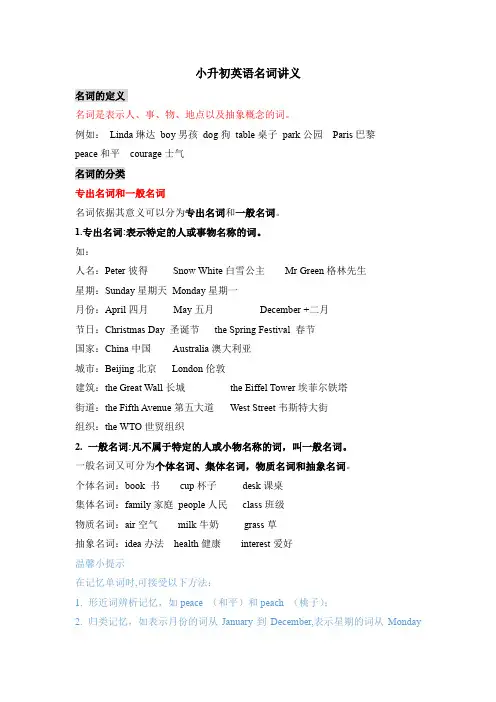
小升初英语名词讲义名词的定义名词是表示人、事、物、地点以及抽象概念的词。
例如:Linda琳达boy男孩dog狗table桌子park公园Paris巴黎peace和平courage士气名词的分类专出名词和一般名词名词依据其意义可以分为专出名词和一般名词。
1.专出名词:表示特定的人或事物名称的词。
如:人名:Peter彼得Snow White白雪公主Mr Green格林先生星期:Sunday星期天Monday星期一月份:April四月May五月December +二月节日:Christmas Day 圣诞节the Spring Festival 春节国家:China中国Australia澳大利亚城市:Beijing北京London伦敦建筑:the Great Wall长城the Eiffel Tower埃菲尔铁塔街道:the Fifth Avenue第五大道West Street韦斯特大街组织:the WTO世贸组织2.一般名词:凡不属于特定的人或小物名称的词,叫一般名词。
一般名词又可分为个体名词、集体名词,物质名词和抽象名词。
个体名词:book 书cup杯子desk课桌集体名词:family家庭people人民class班级物质名词:air空气milk牛奶grass草抽象名词:idea办法health健康interest爱好温馨小提示在记忆单词时,可接受以下方法:1.形近词辨析记忆,如peace (和平)和peach (桃子);2.归类记忆,如表示月份的词从January到December,表示星期的词从Monday到Sunday等;3.同音异形词记忆,如meal (肉)和meet (见而);4.同(近)义词归类记忆,如race (竞赛)和match (比界);5.反义词归类记忆,如day (白天)和night (夜晚)。
可数名词和不行数名词名词依据是否能够用数字来计算,可以分为可数名词和不行数名词。
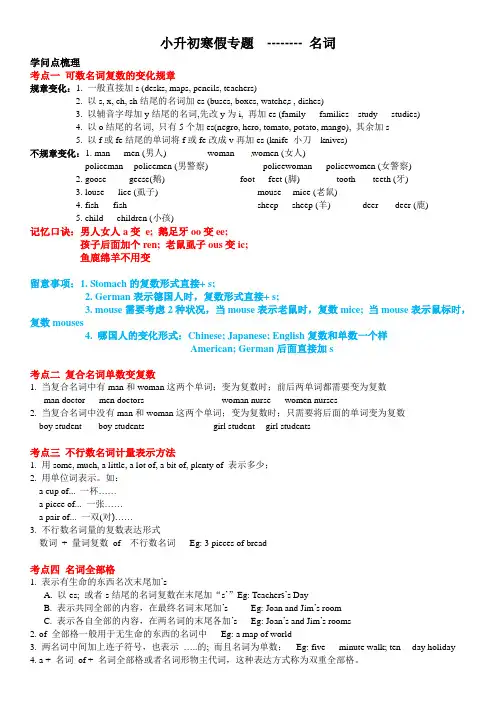
小升初寒假专题-------- 名词学问点梳理考点一可数名词复数的变化规章规章变化:1. 一般直接加s (desks, maps, pencils, teachers)2. 以s, x, ch, sh结尾的名词加es (buses, boxes, watches , dishes)3. 以辅音字母加y结尾的名词,先改y为i, 再加es (family --- families study --- studies)4. 以o结尾的名词, 只有5个加es(negro, hero, tomato, potato, mango), 其余加s5. 以f或fe结尾的单词将f或fe改成v再加es (knife 小刀---knives)不规章变化:1. man --- men (男人) woman --- women (女人)policeman -- policemen (男警察) policewoman --- policewomen (女警察)2. goose ------ geese(鹅) foot --- feet (脚) tooth----- teeth (牙)3. louse --- lice (虱子) mouse ---mice (老鼠)4. fish---- fish sheep --- sheep (羊) deer ---- deer (鹿)5. child --- children (小孩)记忆口诀:男人女人a变e; 鹅足牙oo变ee;孩子后面加个ren; 老鼠虱子ous变ic;鱼鹿绵羊不用变留意事项:1. Stomach的复数形式直接+ s;2. German表示德国人时,复数形式直接+ s;3. mouse需要考虑2种状况,当mouse表示老鼠时,复数mice; 当mouse表示鼠标时,复数mouses4. 哪国人的变化形式:Chinese; Japanese; English复数和单数一个样American; German后面直接加s考点二复合名词单数变复数1. 当复合名词中有man和woman这两个单词;变为复数时;前后两单词都需要变为复数man doctor --- men doctors woman nurse --- women nurses2. 当复合名词中没有man和woman这两个单词;变为复数时;只需要将后面的单词变为复数boy student ---- boy students girl student -- girl students考点三不行数名词计量表示方法1. 用some, much, a little, a lot of, a bit of, plenty of 表示多少;2. 用单位词表示。
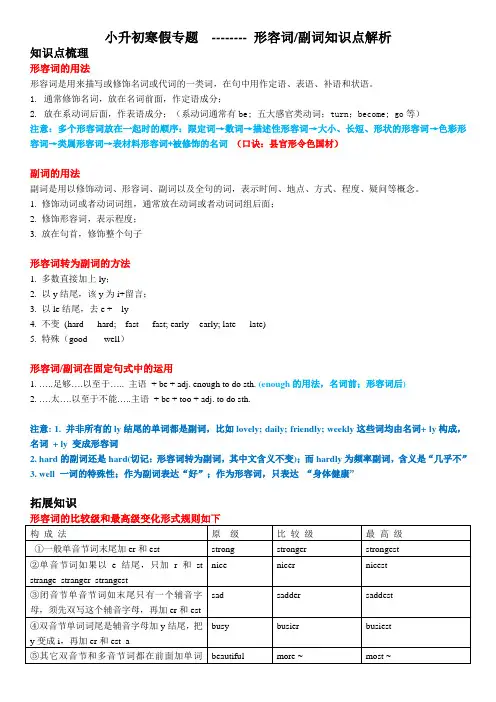
小升初寒假专题-------- 形容词/副词知识点解析知识点梳理形容词的用法形容词是用来描写或修饰名词或代词的一类词,在句中用作定语、表语、补语和状语。
1. 通常修饰名词,放在名词前面,作定语成分;2. 放在系动词后面,作表语成分;(系动词通常有be; 五大感官类动词;turn;become; go等)注意:多个形容词放在一起时的顺序:限定词→数词→描述性形容词→大小、长短、形状的形容词→色彩形容词→类属形容词→表材料形容词+被修饰的名词(口诀:县官形令色国材)副词的用法副词是用以修饰动词、形容词、副词以及全句的词,表示时间、地点、方式、程度、疑问等概念。
1. 修饰动词或者动词词组,通常放在动词或者动词词组后面;2. 修饰形容词,表示程度;3. 放在句首,修饰整个句子形容词转为副词的方法1. 多数直接加上ly;2. 以y结尾,该y为i+留言;3. 以le结尾,去e + ly4. 不变(hard --- hard; fast --- fast; early -- early; late --- late)5. 特殊(good ---- well)形容词/副词在固定句式中的运用1. …..足够….以至于….. 主语+ be + adj. enough to do sth. (enough的用法,名词前;形容词后)2. ….太….以至于不能…..主语+ be + too + adj. to do sth.注意: 1. 并非所有的ly结尾的单词都是副词,比如lovely; daily; friendly; weekly这些词均由名词+ ly构成,名词+ ly 变成形容词2. hard的副词还是hard(切记:形容词转为副词,其中文含义不变);而hardly为频率副词,含义是“几乎不”3. well 一词的特殊性;作为副词表达“好”;作为形容词,只表达“身体健康”拓展知识比较级用法(两者之间)1. 句子中有than(比)2. A or B, which is 比较级3. 有much; far; even修饰最高级用法(三者之间或三者以上)1. 句中有one of2. A, B, or C基础题练习一、写出系动词(至少6个)________________________ ________________________ ________________________ ________________________ ________________________ ________________________二、将下列形容词变为副词1. happy ________________________2. slow______________________3. careful________________________4. quick____________________5. comfortable____________________6. angry___________________7. real ________________________ 8. terrible ________________________ 9. late ________________________ 10. early ________________________ 11. good ________________________ 12. hard_________________三、选择题( )1. He looks .A. happyB. happilyC. sadly( )2. Do you feel now ? Thanks , I’m Ok.A. goodB. wellC. badly( )3. My sister is to look after herself.A. old enoughB. enough oldC. older enough( )4. There isn’t to every student.A. book enoughB. books enoughC. enough books( )5. He is ill today. So he looks .A. tiredB. happilyC. sadly( )6. My brother doesn’t feel today.A. goodB. wellC. happily( )7. The food smells . I don’t like itA. goodB. badlyC. bad( )8. He writes very .A. carefulB. carefullyC. bad( )9. I study very .A. hardB. hardlyC. careful( )10. Our country is becoming _______.A. strongB. stronglyC. richly( )11. Is there in the newspaper?A. something newB. new anythingC. anything new( )12. There is with my bike. It works well.A. nothing wrongB. wrong somethingC. something wrong( )13. He speaks for me to understand.A. too slowlyB. slowly enoughC. enough slowly( )14. He runs to catch up with me .A. too fastB. quick enoughC. quickly enough四、用恰当的词填空1. My father feels ___________ (good) today.2. _________(happy), I passed the exam.3. My father looks ____________(angry).4. My father looks ______________(angry) at me.5. She did her homework very ______________(careful).6. Lily is ____________(care). And she does everything ______________(careful).7. Don’t drive _____________(quick) on rainy days.8. They gave us a _______________(warm) welcome.9. They welcome us _____________(warm).10. The fish taste very ____________(bad).11. The flowers smell _______________(sweet).12. Your ideas sound ________________(great).13. ___________(lucky), he wasn’t badly hurt in the car crash.14. He is _____________(bad) ill.15. There are many _______________(beautiful) flowers.提高题练习一、写出以下各形容词的比较级和最高级1. nice _________ _________2. fat _____ ________3. slow _______ ___________4. dry __________ _________5. happy ________ _________6. wet ________ ____________7. much _______ _________8. ill ________ _________9. little ________ __________ 10. bad _________ _________ 11. thin __________ _________ 12. far _________ ___________ 13. early _______ _________ 14. careful_________ _________ 15. exciting _____ ___________16. busy __________ ________二、根据单词的合适形式填空1. Fred is the _________________ (short ) in his class .2. My book is ____________ ( new ) than my sister’s .3. That piece of chicken is the _________________ ( heavy )in the fridge .4. Her rule is _________________(long), and it’s the __________________(long)of ours all .5. Is a fish ____________________(thin) than a bird ?6. A rose tree isn’t __________________( short ) than a pear tree .7. The leopard can run __________________( fast), but the cheetah can run ________________( fast) than it . It can run ___________________( fast ) in the world .8. Is she the ___________________(old ) woman in the world ?9. Which is __________________( big ), a dinosaur or a blue whale ?The blue whale is ____________________( big ) than a dinosaur , it is the __________________(big) animal in the world . And elephant is the ___________________(big) animal on land .10. My father leaves home __________________(early ) than me .11. This zoo is much __________________(good ) than the old one .12. My brother is much __________________(tall ) than my cousin .13. The shoe shop is ____________________(near) the park .14. This bag is very ___________________( heavy), but that one is __________________(heavy) than this one . It’s the ___________________( heavy) of all .15. Jiamin is __________________( tall ). But Yongxian is __________________( tall ) than him .三、单选题1. Lucy is very short, but she is __________ than her sister.A. shorterB. longerC. tallerD. older2. Sam is __________ at Chinese than Jim.A. goodB. wellC. betterD. gooder3. This one is too large. Can you show me a __________one?A. largerB. largeC. smallD. smaller4. —Do you think March is __________ than January?—Yes, it’s __________ warmer.A. better, a littleB. well, muchC. worse, veryD. nicer, quite5. His Frenc h isn’t so good as __________.A. herB. sheC. hisD. hers6. Her bag is newer than __________.A. mineB. myC. meD. I7. Lin Tao is younger than __________ boy in his class.A. any othersB. any otherC. the otherD. the others8. Which one is __________, this one or that one?A. goodB. badC. bestD. worse9. The weather in North China is colder than __________ in South China.A. \B. thisC. the oneD. that10. I think your room is __________ bigger.A. a lotB. a lot ofC. lots ofD. more11. She is only 2 years old. She is ________go to school.A. too young toB. young enough toC. enough young toD. too young not to12. The room is _____ to put down these things.A. large enoughB. enough largeC. enough bigD. too large13. Do you have ______ to buy the books? --- Yes. But I am too little _____ carry them.A. enough money; toB. money enough; not toC. enough money; / D/ money enough; to14. The room is big enough ____ me to live ____.A. for; inB. to; /C. for; /D. for; on15. She is one of ____________ in our class.A. the tallest studentB. tallest studentsC. the tallest studentsD. tall students基础题练习一、写出系动词(至少6个)feel; look; taste; smell; sound; be; seem二、将下列形容词变为副词略三、选择题ABACA BCBAA CABA四、用恰当的词填空1. well2. Happily3. angry4. angrily5.carefully6. careful; carefully7. quickly8. warm9. warmly 10. bad11. sweet 12. great 13. Luckily 14. badly 15. beautiful提高题练习一、写出以下各形容词的比较级和最高级1. nicer nicest2. fatter fattest3. slower slowest4. drier driest5. happier happiest6. wetter wettest7. more most 8. worse worst 9. little less least10. worse worst 11. Thinner thinnest 12. farther farthest13. earlier earliest 14. More careful most careful15. more exciting most exciting 16. busier busiest二、根据单词的合适形式填空1. shortest2. newer3. heaviest4. longer longest5. thinner6. shorter7. fast faster fastest8. oldest9. bigger; bigger; biggest; biggest 10. earlier 11. better 12. taller 13. nearer 14. heavy; heavier; heaviest 15. tall taller三、单选题CCDAD ABBDA AAAAC。
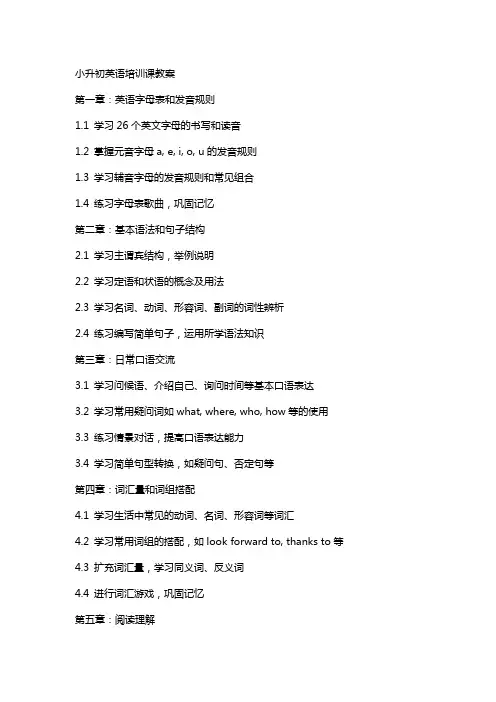
小升初英语培训课教案第一章:英语字母表和发音规则1.1 学习26个英文字母的书写和读音1.2 掌握元音字母a, e, i, o, u的发音规则1.3 学习辅音字母的发音规则和常见组合1.4 练习字母表歌曲,巩固记忆第二章:基本语法和句子结构2.1 学习主谓宾结构,举例说明2.2 学习定语和状语的概念及用法2.3 学习名词、动词、形容词、副词的词性辨析2.4 练习编写简单句子,运用所学语法知识第三章:日常口语交流3.1 学习问候语、介绍自己、询问时间等基本口语表达3.2 学习常用疑问词如what, where, who, how等的使用3.3 练习情景对话,提高口语表达能力3.4 学习简单句型转换,如疑问句、否定句等第四章:词汇量和词组搭配4.1 学习生活中常见的动词、名词、形容词等词汇4.2 学习常用词组的搭配,如look forward to, thanks to等4.3 扩充词汇量,学习同义词、反义词4.4 进行词汇游戏,巩固记忆第五章:阅读理解5.1 学习阅读理解的基本技巧,如找关键词、理解主旨等5.2 练习阅读简单的故事或文章,回答相关问题5.3 提高阅读速度和理解能力,进行计时阅读5.4 学习如何写读后感,表达对文章的观点和感受第六章:写作技巧和练习6.1 学习英语写作的基本结构,包括开头、中间和结尾6.2 学习如何进行段落划分,使文章条理清晰6.3 学习使用连接词和过渡语,使文章连贯流畅6.4 练习写作,以日记、故事或议论文形式进行第七章:听力理解和语音辨识7.1 学习听力理解的基本技巧,如预测、猜词义等7.2 练习听取简单的对话和故事,回答相关问题7.3 提高语音辨识能力,学习区分相似音素7.4 观看英语动画或短片,进行听力训练第八章:口语表达和角色扮演8.1 学习如何在不同的情景下进行口语表达,如购物、问路等8.2 学习使用条件句、并列句等复杂句型8.3 进行角色扮演,模拟真实场景,提高口语交际能力8.4 学习如何进行有效的演讲和汇报第九章:语法加强和练习9.1 学习动词时态,如一般现在时、一般过去时、一般将来时等9.2 学习被动语态和主动语态的用法和转换9.3 学习情态动词,如can、may、must等的用法9.4 进行语法练习,巩固所学知识第十章:综合测试和复习10.1 进行全面的听力、阅读、写作和口语测试10.2 复习整个学期的知识点,查漏补缺10.3 分析测试结果,为学生提供反馈和建议重点和难点解析一、英语字母表和发音规则重点:字母表的书写和读音,元音字母的发音规则。

大家可以推荐一下小学英语的教辅材料吗八1:《薄冰小学英语语法》出版社:开明出版社适用人群:6年级、小升初薄冰先生在国内是绝对的权威,《薄冰小学英语语法》是根据课标编写的,内容涵盖小学英语要求的全部语法知识。
这本语法教辅按照语法点分成16个单元,每个单元1个大的语法点,语法点后面配有简单练习,即学即练,达到巩固强化的目的。
这本语法教辅还配有一本《薄冰小学英语语法练习册》,它的单元划分与语法书一致,每个单元的题目比语法书的题目要多些,用来作补充练习非常好。
2、《小学英语重点攻关》出版社:上海交通大学出版社适用人群:6年级、小升初将小学生在学习和使用英语过程中应掌握的语法知识分解成50个单元。
每个单元左面为对该语法项目进行深入浅出的讲解,随即在右页配有一定量的练习进行操练,以加深印象,巩固所学知识。
这本书的例句经典实用,图文并茂,是广大读者尤其是小学生巩固基础、提高水平的英语语法必备资料。
对于语法,个人觉得最好是系统地学,这样才会有一个完整的体系,掌握的也会更全面。
第三类:非同步教材,但仍然属于大纲范围,属于知识点串联、真题统练这种。
这类教辅更适合学习完一个阶段后,用来普查孩子的综合知识,也适合用于训练孩子的实战能力,再来纠错并查漏补缺。
这类教辅,就是比较通用的,不用太拘泥于教材版本。
1、《黄冈小状元》2、《上海名校名卷》3、《期中期末满分冲刺卷》4、《期末冲刺100分》这类教辅任选其一吧,我选《名校名卷》是因为我们在上海,这套更接近上海教材的真题练习。
听力部分我女儿反应有点快,她基本上要听2遍。
第四类:新概念类虽然我一直强调新概念英语并不是一本应试教材,但外面很多机构用新概念,结果硬生生把新概念上成了鸡血课程。
对此,我只能说,你们…开心…就好……。
学科辅导讲义I will have to finish the work tomorrow.我明天必须完成这项工作。
(3)否定形式don't/doesn't have to表示“不必”,而mustn't则表示“不应该;禁止”。
e. g. You don't have to wait for me.你不必等我。
We mustn't cut in line.我们不应该插队。
7.情态动词should①表示义务,意为“应该;应当;最好”,比must委婉e. g. You should apologize to him.你应该向他道歉。
You should not eat so greedily.你不应该如此贪吃。
My teacher said (that)I should study harder.老师说我应该更加用功地读书。
②与疑问词连用,表示意外、纳闷、惊讶等,意为“究竟是……;到底是……”e. g. Why should you think that way? 你到底为什么会那么想呢?How should I know? 我怎么会知道?8.情态动词:need1. need是一个特殊的情态动词,意为“需要”。
它不仅能作为情态动词使用,还能充当一个实义动词。
如:Need I do my homework now?我必须现在做家庭作业吗?What do you need?你需要什么?2. need用作行为动词时,用法与其它行为动词相同。
如:You don't need to finish it right now.你不用现在就完成它。
We need to have a break.我们需要休息。
Do they need to know this?他们需要知道吗?3. need作为情态动词时,其过去式为need。
但need作为实义动词时,其过去式为needed.如:I'm sorry I need answer a phone call.So I couldn't talk with you yesterday.抱歉我昨天要听电话,没能跟你好好谈谈。
人教版小升初英语复习资料小升初是学生生活中的重要时刻,英语作为一门必修科目,在英语考试中占有很重要的部分。
所以小学生要认真复习英语知识。
下面给大家介绍一些人教版小升初英语的复习资料。
一、基础语法1. 时态:小升初会考的时态有:一般现在时、一般过去时、现在进行时、将来时、过去进行时、过去完成时等。
2. 名词:名词是英语中一个重要的语法概念。
它分为可数名词和不可数名词。
3. 动词:英语动词不仅词形变化比较多,而且还有很多不规则的变化。
所以小升初英语考试中的动词也是需要特别注意的部分之一。
4. 形容词和副词:作为修饰词,形容词和副词在英语语法中也是一个非常重要的部分,是区分不同语境和言语表达方式的关键因素。
二、常用词汇1. 常用动词:动词是英语中最主要的词汇类型之一,常用动词有:be, have, do, eat, drink, walk, run, play, read, write等。
2. 常用名词:名词是生活中最常用的词汇类型之一,常用名词有:book, desk, chair, table, bag, pencil, pen, school, teacher, student 等。
3. 常用连词:连词在英语中常用来连接单词、短语和句子之间的关系。
常用连词有:and, but, or, so, because等。
4. 常用形容词和副词:形容词和副词都是修饰词中的不可或缺的一部分,常用形容词有:good, bad, big, small, happy, sad等。
常用副词有:very, really, quickly, slowly等。
三、常用句型1. 一般现在时:主语+动词原形+其他例句:I eat an apple every morning.2. 一般过去时:主语+动词过去式+其他例句:She watched TV last night.3. 现在进行时:主语+be动词+动词~ing+其他例句:We are playing football now.4. 一般将来时:主语+will+动词原形+其他例句:He will go to the park tomorrow.以上是人教版小学英语复习资料的一些内容。
小升初英语复习资料一、形容词二、be动词1.be动词的三种形式: is, am areIs \am的过去式是was, are的过去式were2.be动词用法口诀: i用am, you用are, is用于she, he, it和单数, 所有复数都用are。
变疑问, 往前提, 句末问号莫丢弃。
变否定, 更容易, be后not莫忘记。
疑问否定任你变, 句首大写莫迟疑。
例如:.a..student.(改为疑问句)------Ar.yo..student.Yes..am..No.I’.not.(改为否定句)-----I am not a student....Yo.ar..student....H..Sh.i..student. (改为疑问句)-------I.he.sh..student.Yes.he.sh.is..No.he\sh.isn’t.(改为否定句)-----He\She is not a student....W.\The.ar.students.(改为否定句)------We\The.ar.no.students. 三、助动词do1.do (第三人称单数形式)-----does(否定形式)-----does not-----doesn’tdo (过去式)------did (否定形式)------did not------didn’tdo(否定形式)-------do not------don’t2.助动词do的用法(1)现在时, 主语是第一或第二人称用do例如: .don’.know. D.yo.know?(2)现在时,主语是第三人称用does例如: Does he\she go to school?He doesn’t hand in his work.(3)过去时, 用did例如: Did he go to school yesterday?3.否定句结构(1)现在时: 主语+don’t\doesn’t+其他I don’t like skating.She\He doesn’t like skating.(2)过去时: 主语+didn’t+其他I didn’t hand in my work.4.一般疑问句(1)当主语是第三人称单数时, 用does,如:Tom likes football.--------Does Tom like football?回答: Yes, he does.\No, he doesn’t.(2)当主语不是第三人称单数时, 用do,如:They like football.--------Do they like football?回答: Yes, they do.\No, they don’t.练习题一、写出下列单词的反义词。
小升初寒假专题-------- 冠词知识点梳理考点一不定冠词a, an的用法1. 不定冠词通常用于单数可数名词前,a用于以辅音音素开头的单词前,而an则用于以元音音素开头的单词前。
2. 表示类别,泛指一类人或物;3. 表示“每一”,相当于every;4. 表示再一次;Eg: a second time 再次5. 用于固定短语中。
考点二定冠词the的用法定冠词the与指示代词this, that, these, those意义相当,用于不可数名词、可数名词单复数前,表示某个或某些定的人或事物。
1. 表示特指时用定冠词the;2. 表示说话双方都知道的人或事;3. 指上文已提到的人或事物;4. 用于世界上独一无二的事物前;5. 用于序数词和形容词最高级前;6. 用在中国乐器名词前;7. 用在姓氏复数形式前,表示“全家人”或“夫妇俩”;Eg: the Blacks 布莱克一家人8. 用于某些固定搭配中。
Eg: same前面必须加the9. 表示一类人Eg: the poor穷人the rich 富人10. 用在含有2个以上名词构成的江河;湖海等;Eg: the Yellow River; the Great Wall考点三零冠词的情况1. 复数名词或不可数名词表示一般意义而不指具体的人或事物时,不用冠词;2. 名词前有this, that, my, your, their, whose, these, some, any, no, each, every等代词时,不用冠词;3. 学科﹑球类﹑三餐前不加任何的冠词;4. 颜色和具体的语言前不加任何冠词;5. 在国名和地名前不用任何的冠词;6. 职务﹑称呼语和头衔前不加任何冠词;7. 用于一些固定短语中。
Eg:by +名词表时候交通方式,不加冠词基础题专练一、运用恰当的a/an填空1. _______ useful book2. ______ university3. _____ unhappy boy4. _____ hour ago5. _____ unusual day6. ______ usual day7. ______ smart dog8. ____ umbrella9. ______”s” and ______”u”10. _____ American student11. _____ English book12. give me ______ cup of coffee13. ______ good boy14. _____ orange15. ______ egg 16. _____ student17. miss ______”m”18. ______ one-year-old baby19. half ______ hour20. _____ honest boy二、用适当的冠词填空1. This is ___ old map. It is ____ useful map.2. _____Blacks are sitting in the living room.3. Which is ________ biggest, ______ sun, _______ moon; or ______ earth?4. This is _______ useful book. I read it for _______ hour.5. There is _____woman over there. ____ woman is Lily’s mother .6. What _____ important news!7. He often goes to _____ school by ____ bike.8. I often watch _____ TV in _____ evening.9. There is _____”s” and _____”m” in _____word”miss.”10. Do n’t play _____ basketball at home. You can play _____ guitar.11. Are ____ Greens going to Shanghai for holiday?12. It will take you half ____ hour together there on ____ bus.13. Let’s go out for _____ walk.st night I saw________ UFO flying in the sky and took pictures of it.15. Tim had tried twice, and his father asks him to have________ third try.16. Many students in our school can play________ guitar.17. Liu Changchun is________ first Chinese to join the Olympics.18. I think it’s________ useful advice, so I will always remember it.19. —Will you get there by________ train? —No, I’ll take _______ taxi.20. We work five days ________ week.21. There’s _______ “u” and _______ “s” in ______ word “use”.22. That’s ______ useful book. I have read it already.23. ______ Whites have moved to a new house.提高题精练1. --- What _______ great time they had at the party yesterday!A. aB. theC. anD. /2. What ____ great fun they had at the party yesterday!A. aB. theC. anD. /3. We’ll go traveling by ____ camel across the desert before we go to ____ university.A. a; /B. /; anC. /; /D. /; a4. ____ Greens are preparing for the coming Thanksgiving Day.A. aB. theC. anD. /5. This summer, I’m going to visit _____ Great Wall.A. aB. theC. anD. /6. ____ apple a day keeps the doctor away.A. AnB. TheC. AD. /7. At that time, Tom was _____ one-year-old baby.A. aB. theC. anD. /8. ____ useful book it is!A. What aB. How aC. What anD. What9. One afternoon, he found ____ handbag. There was ____”s” on the corner of _____ handbag.A. a; a; theB. a; an; theC. an; an; aD. the; an; the10. ____ Great Wall is ____ longest wall in the world.A. The; aB. The; aC. /; /D. The; the11. The museum is quite far. It will take you half ____hour to get there by ____ bus.A. an; aB. a; aC. an; /D. /; a12. ___ elephant is much heavier than _____ horse.A. A; aB. The; theC. An; aD. /; /13. Washington is _____ capital of ____ USA.A. the; theB. a; theC. a; /D. the; /14. After watching TV, she played ____ violin for _____ hour.A. the; theB. a; theC. a; aD. the; an15. Susan, _____ university student from Europe, teaches me _____ art in her free time.A. an; /B. a; theC. a; /D. a; a16. Now he is _____ artist. I have known him(认识)since(自从) he was _____ one –year-old boy.A. a; anB. an; aC. an; anD. a; a17. We found that we should do more for _______ poor in the poor area.A. /B. aC. theD. those18. They went to see _____Yellow River two days ago. And they arrived(到达) ______ home yesterday.A. the; /B./; theC. /; /D. the; the19. The boy is on ____ left of that boy. And two boys look ____ same.A. the; theB. /; /C. a; aD. the; /20. We should give the seats to _______ elderly on the bus.A. theB. /C. aD. an21. _____ Browns live in ___United States.A. The; theB. /; /C. A; aD. the; /22. _____ Spring Festival is ____ most important holiday in _____ China.A. The; the; theB. /; /; theC. A; a; /D. The; the; /23. Do you like studying _____Maths or ______Chinese?A. the; theB. /; /C. a; aD. the; /24. I think it is _____ hard work for me to finish the job in twenty minutes.A. theB. /C. aD. an25. Does Wuxi have_____ airport? --- Yes, we can go to ____ UK on ____ plane.A. a; the; /B. an; the; theC. the; the; aD. the; the; /基础题专练答案一、运用恰当的a/an填空1~ 10 : A; a; an; an; an; a; a; an; an, a; an;11~20: an; a; a; an; an; a; an; a; an ;an二、用适当的冠词填空1. an; a2. The3. the; the; the ; the4. a; an5. a; The6. /7. /; /8. /; the9. an; an; the 10. /; the 11. the 12. an; the 13. a 14.a 15. a 16. the 17. the 18. / 19. /; a 20.a21. a; an; the 22. a 23. The提高题精练ADDBB AAABD CCADC BCAAA ADBBB。
小升初寒假专题-------- 感叹句/祈使句知识点梳理感叹句what / how的使用1. what的使用,what用于修饰名词或者名词词组;做题时找准感叹句中的主语,再看主语前面的单词的词性;Eg: What good news we heard! We heard是这句话的主语和谓语动词,而we前面的单词news是名词,所以用what.What的类型:what + a / an +adj. +名词单数+ 主语+ 谓语+ 其他!what + adj. +名词复数+ 主语+ 谓语+ 其他!what +adj. +不可数名词+ 主语+ 谓语+ 其他!2.how的使用,how用于修饰副词或者修容词,做题时,方法同上。
Eg: How good the news was! 这句中的主语是the news, 而主语前面是good, good是形容词, 所以用how.How的类型:How + adj./ adv + 主语+ 谓语+ 其他!注意: 1. 感叹句what / how的本质作用,只是起到增强语气的作用,在句子中不会充当任何的成分。
做完题目后,可以去掉what/how。
来还原句子,检测答案对不对。
2. 感叹句what一词,一定要考虑名词的单复数问题以及名词的不可数性问题。
3. 若在词汇的正确形式中遇到感叹句,切记去感叹词what; how;然后将句子还原来做题。
祈使句的使用祈使句分类:肯定祈使句----- A. 行为动词原形+ 其他B. Be 动词+ 其他否定祈使句----- A. Don’t 行为动词原形+ 其他B. Don’t be 动词+ 其他C. No + ving特殊祈使句:Let sb. do sth. / Let sb. not do sth.祈使句的回答:用will或者won’t来回答。
如果句子是肯定,就用will; 如果是否定,就用wo n’t.Eg:---- Don’t drive so quickly, Bobby. ---- Ok, I won’t.祈使句的反义疑问句:Let’s的反义疑问句,shall we?其余的祈使句的反义疑问句,will you?注意: 1. No + 名词,名词一般是复数2. 祈使句和反身代词的内容放在一起时,注意反身代词的单复数问题。
小升初寒假专题-------- 代词学问点梳理主格和宾格的用法主格宾格单数复数单数复数第一人I We me us称其次人称you you you you第三人称She/ he / it they Her /him/ it them留意:人称代词的挨次;当人称代词试单属实,遵循321原则。
当人称代词是复数时,遵循123原则。
形容词性物主代词和名词性物主代词形容词性物主代词名词性物主代词单数复数单数复数第一人称my our mine ours其次人称your your yours yours第三人称Her/ his/ its their Hers /his/ its theirs记忆口诀:形容词性物主代词+ 名词= 名词性物主代词留意:在表示a friend of….结构中;of后面用名词性物主代词A few / a little / few / little的用法1. few与few 都是用来修饰可数名词复数;a few表达确定的含义;few表达否定的含义;一般将a few翻译为一些;few翻译为几乎没有。
2. little与little都是用来修饰不行数名词;a little表达确定的含义;little表达否定的含义;一般将a flittle翻译为一些;little翻译为几乎没有。
留意:a little还可以翻译为“一个小的......" Eg: a little sheep 翻译为“一只小羊”,留意这里的sheep属于可数名词反身代词单数复数第一人称Myself ourselves其次人称yourself yourselves第三人称Herself / himself /itself themselvesteach oneself 自学by oneself 独自留意:在祈使句中,反身代词一律用yourself或者yourselves. 留意区分是单数还是复数。
复合不定代词的用法1. 当复合不定代词作主语时,将其看成第三人称单数. Eg: Everything is fine.2. 当复合不定代词与形容词放在一起时,形容词在后面。
新小五英语学习辅导教材一、基础语法学习1.音标2.人称代词3.语法二、阅读训练技巧内部讲义及训练二十天三、写作技巧及范文欣赏音标英语共有48个音标,其中辅音音标28个,元音音标20个。
记得我们小学认字的时候就是从拼音开始,英语中的音标就充当了汉字中的拼音角色,辅音相当于声母,元音相当于韵母。
先来看元音音标,里面包括12个单元音和8个双元音。
单元音:[i:] [i] [e] [ae] [a:] [۸] [ə:] [ə] [u:] [u] [כ] [:כ]双元音:[ai] [ei] [iə] [əu] [uə] [au] [eə] [כi]辅音音标:分为清辅音和浊辅音,清辅音发音时声带不振动,浊辅音发音时声带振动。
清辅音:[p][t][k][f][s][θ][∫][ts][t∫][tr]浊辅音:[b][d][g][v][z][δ][з][dz][dз][dr]其他: [h][l][r] [m][n][ŋ] [w][j] 英语国际标准音标练习/i:/ bee/bi:/ feet/fi:t/ keep/ki:p/ key/ki:/ team/ti:m/ meet/mi:t/ /i/ it /it/ big/big/ city/siti/ give/giv/ sick/sik//e/ get/get/ best/best/ text/tekst/ help/help//æ/ fat/fæt/ have/hæv/ cat/kæt/ back/bæk/ hat/hæt//a:/ laugh/la:f/ glass/gla:s/ half/ha:f/ farm/fa:m/ park/pa:k// ɔ:/ horse/hɔ: s/ saw/sɔ:/ corn/kɔ:n/ course/kɔ:s/ salt/sɔ:t// ɔ / dog/dɔg/ pot/pɔt/ cost/kɔst/ what/wɔt/ honest/′ɔnist//u:/ food/fu:d/ moon/mu:n/ rule/ru:l/ loose/lu:s/ noon/nu:n//u/ book/buk/ put/put/ good/gud/ would/wud/ could/kud// ʌ / must/mʌst/ does/dʌz/ money/′mʌni/ ugly/′ʌgli/ come/kʌm//ə:/ nurse/nə:s/ bird/bə:d/ burn/bə:n/ turn/tə:n/ girl/gə:l//ə / better/betə/ never/nevə/ worker/wə:kə/ welcome/welkəm//ei/ may/mei/ name/neim/ game/geim/ eight/eit/ age/eidʒ//əu/ no/nəu/ home/həum/ hope/həup/ wrote/rəut/ note/nəut/ pose/pəuz//ai/ eye/ai/ time/taim/ buy/bai/ right/rait/ bike/baik/ kite/kait//au/ now/nau/ out/aut/ how/hau/ about/ ə′baut/ south/sauθ/ house/haus//ɔi/ boy/bɔi/ toy/tɔi/ noise/nɔiz/ voice/vɔis/ point/pɔint/ coin/kɔin/ /iə/ ear/iə/ near/niə/ idea/ai′diə/ hear/hiə/ mere/miə/ spear/spiə//εə/ air/εə/ tear/tεə/ care/kεə/ dare/dεə/ fair/fεə/ there/ðεə//uə/ tour/tuə/ poor/puə/ sure/ʃuə/ moor/muə/(停泊) your/juə//θ/ bath/ba:θ/(v洗澡) thick/θik/ mouth/mauθ/ breath/breθ/(n呼吸) thought/θɔ:t/ author/´ɔθə/ truth/tru:θ//ð/ the/ ðə/ they/ðei/ that/ðæt/ mother/′mʌðə/ thus/ ðʌs/ then/ðen//s/ face/feis/ mouse/maus/ cakes/keiks/ caps/kæps/ likes/laiks/stops/stɔps//z/ close/kləuz/ keys/ki:z/ boys/bɔiz/ pens/penz/ halves/ha:vz//tʃ/ catch/kætʃ/ cheep/tʃi:p/ rich/ritʃ/ watch/wtʃ/ child/tʃaild/ question/kwestʃən/ teach/ti:tʃ/ challenge/tʃlindʒ//dʒ/ orange/′ɔridʒ/ large/la:dʒ/ juice/dʒu:s/ job/dʒɔb//tr/ tree/tri:/ try/trai/ true/tru:/ trouble/traubl/ track/træk//dr/ dry/drai/ dream/dri:m/ dress/dres/ drink/driŋk/ hundred/′hʌndrid//ʃ/ she/ʃi:/ sharp/ʃa:p/ fish/fiʃ/ shock/ʃɔk/ shoe/ʃu://ʒ/ pleasure/′pleʒə/ measure/′meʒə/ television/′teliviʒən//ts/ let′s/lets/ sports/spɔ:ts/ puts/puts/ writes/raits/ seats/si:ts//dz/ hands/hændz/ birds/bə:dz/ friends/freindz/ beds/bedz/ stands/stændz/ /h/ he/ hi:/ hard/ha:d/ him/him/ heard/hə:d/ half/ha:f//j/ you/ju:/ few/fju:/ yard/ja:d/ music/′mju:zik/ student/′stju:dnt/ excuse/ik′skju:z//w/ work/wə:k/ way/wei/ well/wel/ what/wɔt/ twelve/twelv/ twin/twin/ /r/ red/red/ road/rəud/ write/rait/ wrong/rɔŋ/ problem/′prɔbləm/音标综合练习1./i:/ /i/ /e/ /æ//bit/ /wi:k/ /di:l/ /riəl/ /kid/ /dig/ /kwik/ /tip/ /zip/ /rid//wil/ /fil/bit week deal real kid dig quick tip zip rid will fill/pet/ /pæk/ /gæp/ /kæg/ /næg/ /ræm/ /bætl/ /sed/ /′hæpi/ /ten//red/pet pack gap cap nag ram battle said happy ten red/′setl/ /træʃ/ /di′pend/settle trash depend2./a:/ / ɔ:/ / ɔ / /u:/ /u//a:sk/ /ma:sk/ /pa:st/ /fra:ns/ /ɔd/ /lɔ:n/ /nɔ:t/ /pɔ:z/ /fɔks//sɔk/ask mask past France odd lawn naught pause fox sock/fa:/ /la:dʒ / /ma:k/ /lɔ:d/ /tɔ:/ /stɔ:m/ /pɔt/ /krɔp/ /θɔt//prɔmis/far large mark Lord torch storm pot crop thought promise/huk/ /lu:s/ /sut/ /tuk/ /mud/ /θru:/ /pul/ /wud/hook loose soot took mood through pull wood3./ʌ/ /ə/ /ə//mʌnθ/ /θi:f/ /ðæt/ /ðæn/ /feiθ/ /tə′geðə/ /θæŋk/ /ðəm′selvz/ month thief that than faith together thank themselves一. 音标【注意区别】:[i:] 字母组合:ee ea e iethree tree green sheep meet beef see seekeat tea meat leave lead teacher team mean speak cleanpiece receive[i] 发音字母i y esit picture it is list six mix fix fit pig big build missmyth many twenty happy dictionarydefect decide delicious[ε:] 字母组合ir ur ear er orgirl shirt skirt thirty thirteen third birdturn burn murder nurse turtle Thursday burgerlearn earn earth heardterm her servework worm work world[ε] 字母组合er or ou ar o a e uteacher leader remember player speaker farmer powderdoctor actor mayor officer tigerdelicious pleasure overfamiliar dollartogether tomorrow today lesson Washington controlaround account ago elephant manta banana Canada Japan chinamen listenfamous Saturday[u:] 字母组合oo o ufood moon room gloom broom doom goose toothshoe do twotrue truth blue full[u] 字母组合oo ou u olook good foot book woodshould couldput full bull pull pushwoman wolf找出画线部分读音不同的单词( ) 1. A. tea B. meat C. weather D. beach ( ) 2. A. back B. fast C. have D. map ( ) 3. A. warm B. garden C. market D. party( ) 4. A. school B. tooth C. choose D. good ( ) 5. A. book B. too C. look D. cook( ) 6. A. June B. ruler C. put D. menu( ) 7. A. push B. fun C. sun D. cut( ) 8. A. tiger B. her C. officer D. over ( ) 9. A. go B. no C. cold D. hot( ) 10.A. like B. lion C. pizza D. Friday[lesn ] [hæpi ][fæmili] [plei][fɔks] [tə′geðə] [meni] [taigə ]12个单元音长元音[ ] [ ] [ ] [ ] [ ]短元音[ ] [ ] [ ] [ ] [ ] [ ] [ ]1) [i:] 字母组合:ee ea e iethree tree green sheep meet beef see seekeat tea meat leave lead teacher team mean speak cleanpiece receive ceiling2) [i]发音字母i y esit picture it is list six mix fix fit pig big build missmyth many twenty happy dictionarydefect decide delicious3) [æ] 发音字母abag hand and ant happy hat map mad bad black back glad flag shall man 4) [e] 字母组合ea e ahead bread pleasureelephant electric remember sell shell lesson better bed desk hotel yes many any5) [ε:] 字母组合ir ur ear er orgirl shirt skirt thirty thirteen third birdturn burn murder nurse turtle Thursday burgerlearn earn earth heardterm her servework worm work world6) [ε] 字母组合er or ou ar o a e uteacher leader remember player speaker farmerdoctor actor mayor officer tigerdelicious pleasure overfamiliar dollartogether tomorrow today lesson Washington controlaround account ago elephant manta banana Canada Japan chinamen listenfamous Saturday7) [a:] 字母组合ar acar farm card arm gardenfast class last glass plant aunt calm8) [ :] 发音字母u o ou ooup supper lunch fun gun hunt cup buscome mother brother love abovetrouble rough flourishblood flood9) [ ]字母组合al or au our arsmall wall talk tall hall ball call walkshort more lord horse for forty sport door floor storeauthor caught autumnfour mourn court boughtwarm quarrel quarter10) [ ] 发音字母o ahot lost lot fox box mop hop loss collar notwant wash watch11) [u:] 字母组合oo o ufood moon room gloom broom doom goose toothshoe do twotrue truth blue full prude12) [u] 字母组合oo ou u olook good foot book woodshould couldput full bull pull pushwoman wolf找出画线部分读音不同的单词( ) 1. A. tea B. meat C. weather D. beach ( ) 2. A. back B. fast C. have D. map( ) 3. A. warm B. garden C. market D. party ( ) 4. A. school B. tooth C. choose D. good ( ) 5. A. book B. too C. look D. cook( ) 6. A. June B. ruler C. put D. menu( ) 7. A. push B. fun C. sun D. cut( ) 8. A. tiger B. her C. officer D. over ( ) 9. A. go B. no C. cold D. hot( ) 10.A. like B. lion C. pizza D. Friday 看音标写单词二. 冠词的用法冠词是虚词,放在名词之前,用来说明名词指的人或事物。